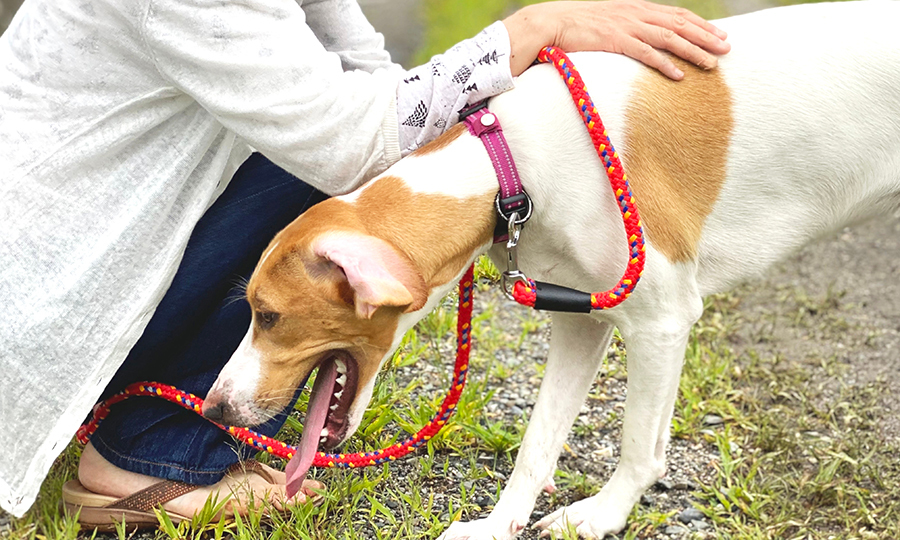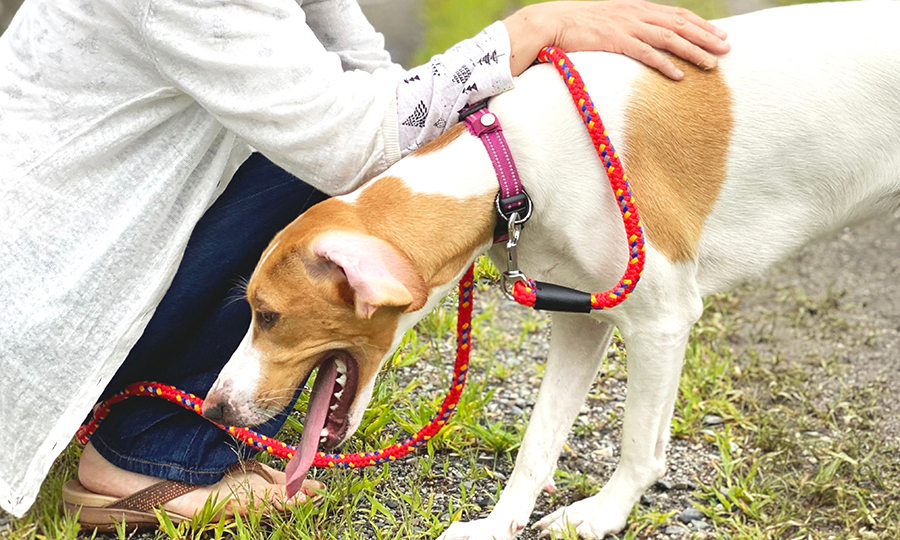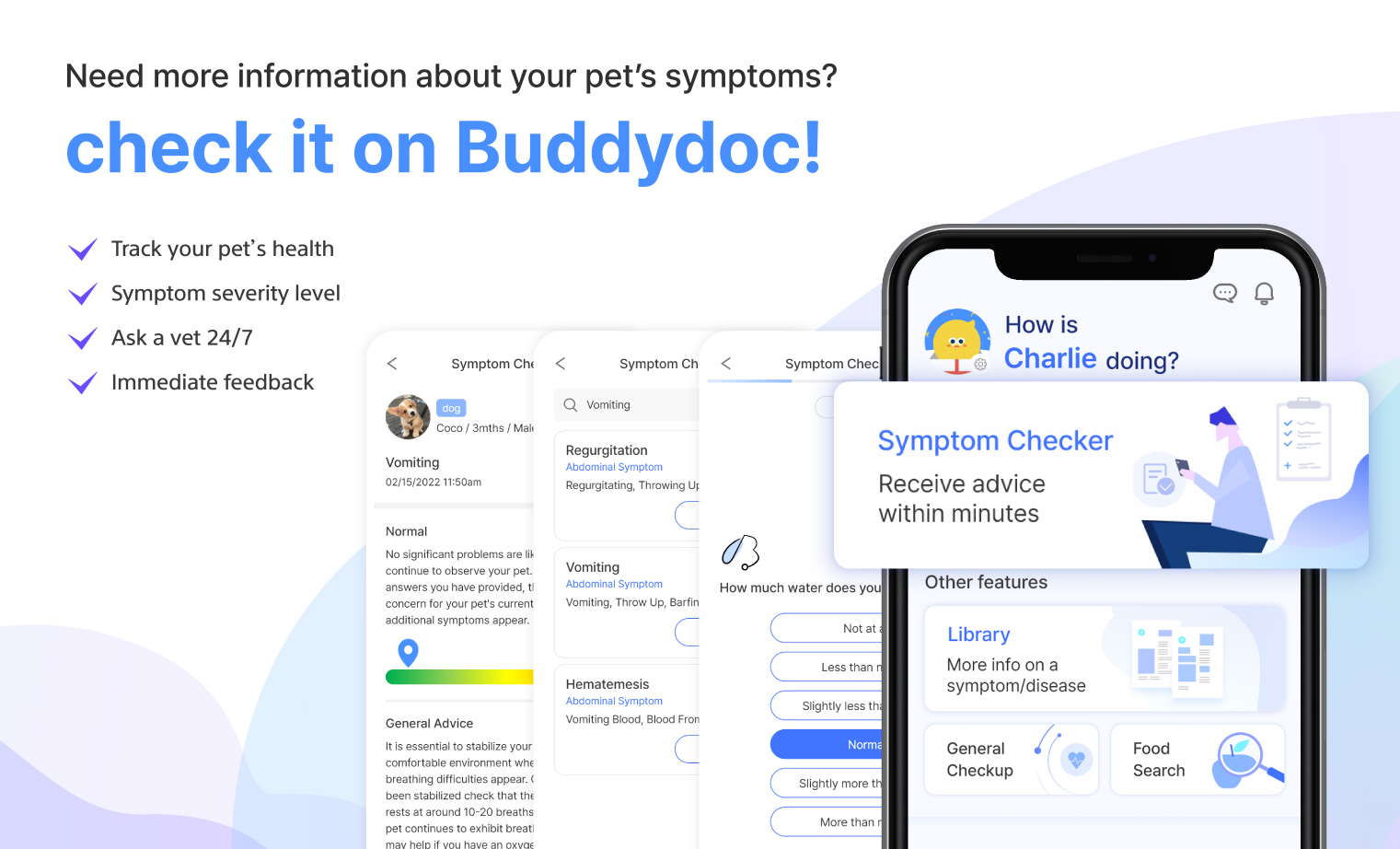SYMPTOMS
Why is My Dog Vomiting? What Does the Color of Dog Vomit Mean?
페이지 정보
본문


What is vomiting in dogs?
Vomiting is a relatively common symptom in dogs, with many potential causes. It may result from eating too quickly or consuming certain food or things, such as grass or contaminated water. However, in some cases, vomiting could indicate underlying health issues or illness, making it critical to understand the underlying cause and recognize when it warrants urgent medical attention. It is important to be aware of the potential causes of vomiting in dogs and learn to distinguish between harmless instances and more serious conditions that require an immediate visit to the vet.
Vomiting vs regurgitation
A key factor to distinguish first is the difference between vomiting and regurgitation.
-
Vomiting
Vomiting is the act of forcibly expelling the contents of the stomach and upper intestine, which can include partially digested food or yellow bile and emit a sour odor. This is usually preceded by symptoms of nausea such as drooling, lip licking, swallowing, and abdominal contractions. You may notice that some puppies eat grass to induce vomiting or protect their esophagus, it is important to avoid overfeeding to prevent this. While it may be concerning, it's worth noting that dogs instinctively eat their own vomit, which does not pose a major health problem in most cases.
-
Regurgitation
Regurgitation refers to the expulsion of undigested food, which differs from vomiting in that the food does not reach the stomach. This typically occurs immediately after food intake, without any abdominal movement like gurgling. It's often caused by eating too much or too quickly and can also be triggered by excitement or stress. However, unlike vomiting, regurgitation may be accompanied by symptoms like difficulty breathing or coughing. If your dog continues to regurgitate food, it's recommended to seek medical attention to determine the exact cause of the symptom.
Causes of vomiting in dogs

The reasons behind vomiting are multifaceted and can be affected by a variety of factors including illness, dietary habits, age, breed, and behavioral issues.
The most common causes of vomiting in dogs
- Sudden change in diet
- Drinking contaminated water (puddles, public dog water fountains, etc.)
- Ingestion of foreign bodies such as grass, toxins, stool, possible intestinal obstruction, etc.
- Motion sickness, heat stroke
- Food allergy or food intolerance
- Reaction to a medication
- Head trauma
The most common causes of vomiting from diseases
- Inflammatory bowel disease (IBD)
- Addison’s disease (hypoadrenocorticism)
- Diabetes mellitus (DM)
- Gastritis, gastroenteritis, gastrointestinal ulcer, or hemorrhagic gastroenteritis
- Infection (bacterial, viral, fungal, parasitical)
- Kidney disease, liver disease, or pancreatitis
- Brain tumor or meningitis
- Middle ear infection
- Cervical infection
- Tumor
The most common causes of acute vomiting in dogs
Acute vomiting refers to sudden vomiting that does not last for a long time or persist over a period.
Acute vomiting can be caused by the following:
-
Dietary problems or foreign body ingestion
It is common for young puppies to engage in behaviors such as sifting through garbage or eating poisonous foreign substances such as plants while outside. These actions can lead to health issues if left unattended. If the consumed substance does not cause intestinal obstruction, it can progress to chronic vomiting without the parent’s knowledge. If a dog consumes food that is high in fat, it may result in the development of pancreatitis.
-
Infectious diseases
In young puppies, contagious diseases like parvovirus may cause vomiting, which can be a severe and alarming condition. Some breeds are more susceptible to parvovirus infection, such as Rottweilers, Doberman Pinschers, German Shepherds, Labrador Retrievers, and sled dog breeds.
-
Intestinal parasites
A dog with chronic vomiting may be hosting parasites in its intestines without the parent’s knowledge. Parasites are occasionally visible in the vomit, but they are typically invisible, and only their eggs can be detected through fecal samples.
-
Contaminated water
If your dog has consumed water from puddles or a public water bowl, they may experience vomiting as a result of a bacterial infection. However, ingestion of lake water that contains high levels of green algae can be far more dangerous and may even lead to death. Initial symptoms of vomiting may occur, followed by the development of neurological symptoms, which can ultimately result in death.
-
Bloat
Gastric dilation and volvulus (GDV) is a serious and time-sensitive condition that requires immediate and aggressive treatment. In this condition, air gets trapped and twisted in the dog’s stomach, which can impede the circulation of air and lead to shock. It is more frequently observed in dogs that belong to large breeds or have deep chests, such as German Shepherds, Great Danes, Standard poodles, Labradors, and Golden Retrievers. Eating/drinking too fast or too much food or water can cause this type of bloating.
The most common causes of chronic vomiting in dogs
Chronic vomiting is defined as frequent episodes of vomiting that occur over an extended period. Dealing with chronic vomiting can be frustrating, especially when the underlying cause is unknown. Here are several common causes of chronic vomiting you can monitor closely for.
-
Megaesophagus
Megaesophagus is a medical condition characterized by a generalized enlargement of the esophagus. This condition can affect dogs of all ages, and it may be either congenital or acquired. In some cases, dogs may be born with megaesophagus, while in others, it can be caused by conditions such as Addison's disease, myasthenia gravis (MG), or hypothyroidism.
-
Inflammatory bowel disease (IBD)
Inflammation in the intestines can manifest in various ways, and although IBD may initially present similarly to a lower gastrointestinal disease, it has the potential to impact the entire gastrointestinal tract. As a result, vomiting is often a primary symptom experienced by dogs with IBD.
-
Some dogs may experience chronic vomiting due to chronic pancreatitis. Therefore, if pancreatitis is suspected in a patient, it is recommended to provide them with a low-fat diet to help mitigate it. The following breeds are prone to pancreatitis, Schnauzers, Shetland Sheepdogs, Yorkshire Terriers, Poodles, and Bichon Frises.
Dog vomit color guide and what each color can mean
The color and shape of the vomit can help determine the cause of the vomit.
-
Yellow vomit
Yellow vomit color is due to the secretion of bile, and it is often observed when the stomach content is mostly empty. When this type of vomit is expelled, it gets mixed with the air, which can cause the appearance to be foamy as well.
-
White, foamy vomit
White foamy vomit is caused by the accumulation of stomach acid resulting from reflux of the contents of the stomach or upper small intestine or other underlying problems with the stomach. When your dog's stomach is empty, gastric secretions may reflux due to swelling/bloating, leading to white vomit. When the vomit is expelled, it mixes with the air, which can cause the appearance to be foamy as well.
-
Clear, liquid vomit
When a dog feels nauseous and drinks water, vomiting of clear liquid is typically caused by the secretion of stomach acid or water that has been sitting in the stomach.
-
Mucus-like, slimy vomit
When a dog has saliva pooling in the stomach and experiences nauseous symptoms, mucous, slimy-like vomit may be produced. This type of vomit is typically a response that can actually help relieve nausea in the dog.
-
Brown vomit
Brown vomit is a common occurrence when food is regurgitated from the esophagus before reaching the stomach, often caused by dogs eating too quickly or swallowing too much air during meals. Additionally, consuming feces may also result in this color of vomit. However, it's essential to note that dark brown vomit should be taken seriously as it could indicate blood present, which requires prompt attention.
-
Green vomit
Green vomit is a type of vomiting that is caused by the presence of bile. This can happen when the gallbladder contracts on an empty stomach, causing the bile to flow back into the stomach. In addition, if your dog eats plants like grass or leaves while out on a walk, they may also vomit green.
-
Red or bloody vomit
Red vomit is a concerning symptom that could indicate internal bleeding, potentially requiring an emergency response. Nausea is often caused by the presence of blood, and when it remains in the upper gastrointestinal tract, vomiting may occur. If the vomit contains blood, blood clots, or resembles coffee grounds, this suggests bleeding from the stomach or upper small intestine. Bleeding in the upper gastrointestinal tract can stem from a variety of causes, including ulcers, tumors, coagulation disorders, or ingestion of toxic substances like rat poison, and immediate treatment is essential if this type of vomit is observed.
-
Grass in vomit
When puppies are not feeling well, they often eat grass to induce vomiting or clear their esophagus.
-
Parasitic vomit (worms)
Vomiting caused by an infection of parasites can be visible in the vomit or the feces of the parasites can be observed.
When to see a vet for a dog vomiting
Even though healthy dogs may vomit without any apparent reason, a single instance of vomiting doesn't necessarily indicate a severe health issue. However, if your dog vomits twice or more in a day or for extended periods, it could lead to dehydration, which could, in turn, cause other health issues. Dehydration is more common in young puppies and older dogs who may be more susceptible to it. If young puppies are not vaccinated periodically, they may be vulnerable to infectious diseases in this state as well. Extra care should be given to senior dogs as vomiting could be caused by various illnesses at older ages.
It is recommended to see a doctor if your dog experiences any of the following symptoms:
- Vomiting consecutively several days in a row or persists over a long period
- Blood in vomit
- Continues to retch or dry heave
- Vomiting and diarrhea present together, especially bloody diarrhea
- Foreign body or toxin ingestion is suspected
- Pale gums
- Symptoms of dehydration, such as dry gums or skin not returning to its original position when pulled
- If there is a known underlying disease present
- If accompanied by the following symptoms: high fever, loss of appetite, weight loss, lethargy, or abdominal pain.
How to deal with vomiting in dogs at home
When your dog is vomiting, it is important to take precautions to prevent vomit from entering their respiratory tract. To avoid this, it is recommended to make sure their head is lower than their body and do your best not to touch them to cause sudden movements. If a dog's vital signs are normal and they are eating well after vomiting, their condition can be monitored at home. However, it is recommended to limit water and food for 2 to 3 hours after vomiting. If symptoms subside, a small amount of water can be offered at first, and if there is no vomiting within an hour, 1/4 to 1/3 of the usual amount of food can be given again. Foods like chicken, boiled potatoes, pumpkin, and rice may help relieve symptoms in the meantime. It is important to avoid prescribing medicines intended for humans as they may contain anti-inflammatory drugs and steroids that can cause gastrointestinal bleeding in dogs. Always consult with a veterinarian regarding the use of any type of medication at home.
Diagnosing vomiting in dogs

Because there are so many causes of vomiting in dogs, your veterinarian may have to ask you several questions to determine which tests are necessary to make an accurate diagnosis.
Some of the following questions may be asked:
- When did the vomiting start and how frequent are the episodes?
- What is the color and shape of the vomit?
- Does your dog have a history of rummaging through trash? or recently rummaged through trash or ingested any foreign substances during a walk?
- Have there been any recent changes in your dog’s diet?
- Are there any other symptoms besides vomiting?
- Are there any changes in your dog’s activity level, appetite, or behavior?
Given that vomiting is a common symptom associated with multiple underlying causes, further testing is typically determined based on the outcomes of these questions and a physical examination. Your veterinarian will conduct a range of necessary tests, including blood tests, radiographs, ultrasounds, endoscopy, biopsies, and urine and feces analyses to determine what is causing this symptom in your dog.
How is vomiting in dogs treated?
The treatment for vomiting will differ according to the underlying cause behind this symptom. A veterinarian will select the appropriate treatment plan that can include, a prescribed diet, medication, and other viable treatments. Vomiting can result in dehydration, electrolyte imbalances, and acid-base disorders. Therefore, a comprehensive treatment regimen may include fluid and electrolyte correction to address these concerns.
The following drugs can be used as antiemetics to stop vomiting:
-
Cerenia
The main ingredient in this medication is maropitant citrate, which is a drug that effectively suppresses vomiting. It is a relatively new drug that has been used in dogs and works by acting on the brain to stop nausea and receptors in the stomach. In addition to the Cerenia injection, your veterinarian may also prescribe a medication that can be taken afterward to help with the treatment.
-
Reglan
The main ingredient in this drug is metoclopramide, which can be particularly effective in dogs that suffer from gastrointestinal motility disorders such as megaesophagus.
-
Zofran
The main ingredient is Ondansetron which is used as a common anti-nausea medication.
How to prevent vomiting in dogs
Vomiting is a common symptom any pet parent will experience in their lifetime, but it can be prevented to an extent by managing their pet’s diet and eating habits. If or when you change a dog's diet, it is important to do so slowly rather than suddenly, as their digestive system may not be able to adapt to the new food that quickly. Gradually increasing the ratio of the new food by mixing it with the food your dog has been eating can help them adjust smoothly. Additionally, when your dog is eating, it is best to avoid consuming their meal or drinking too quickly.
It may be tempting and their puppy dog eyes may be convincing but it is typically better to avoid feeding dogs human food scraps. If you know what is safe and not safe to feed your pets, this tip is the best way to avoid a problem. Certain foods such as grapes, chocolate, macadamia nuts, and high-fat foods can be fatal to a dog's health. Furthermore, it is crucial to prevent your dog from rummaging through trash or ingesting foreign substances and to be cautious that your dog does not eat any grass during outdoor activities.
Find out more about your dog’s symptoms and diseases on the Buddydoc app!

The Buddydoc library is filled with everything you’d want to know about each symptom and disease your pet may experience. If you would like to find out more about the causes, signs, treatments, preventions, and more for your dog’s disease. Try out the Buddydoc app and search for your pet’s symptoms or diseases in the Buddydoc library.













